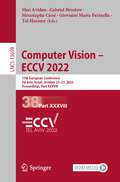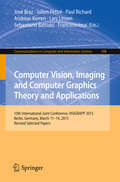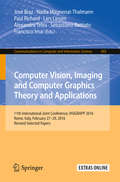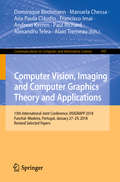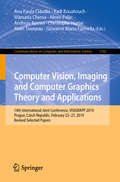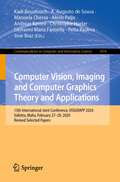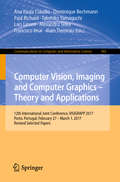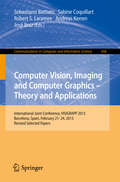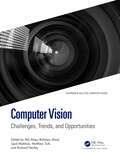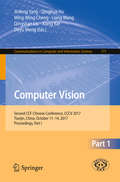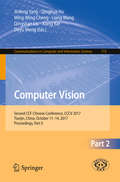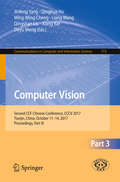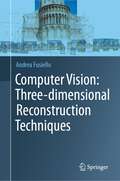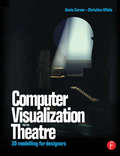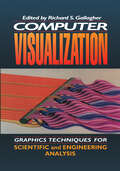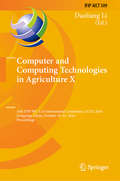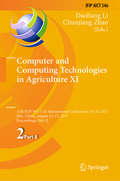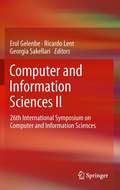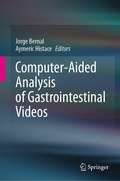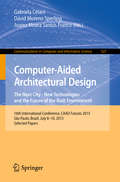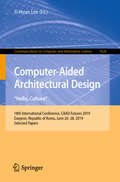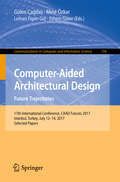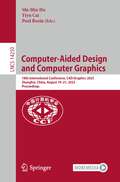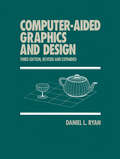- Table View
- List View
Computer Vision – ECCV 2022: 17th European Conference, Tel Aviv, Israel, October 23–27, 2022, Proceedings, Part XXXVIII (Lecture Notes in Computer Science #13698)
by Giovanni Maria Farinella Tal Hassner Shai Avidan Gabriel Brostow Moustapha CisséThe 39-volume set, comprising the LNCS books 13661 until 13699, constitutes the refereed proceedings of the 17th European Conference on Computer Vision, ECCV 2022, held in Tel Aviv, Israel, during October 23–27, 2022. The 1645 papers presented in these proceedings were carefully reviewed and selected from a total of 5804 submissions. The papers deal with topics such as computer vision; machine learning; deep neural networks; reinforcement learning; object recognition; image classification; image processing; object detection; semantic segmentation; human pose estimation; 3d reconstruction; stereo vision; computational photography; neural networks; image coding; image reconstruction; object recognition; motion estimation.
Computer Vision, Imaging and Computer Graphics Theory and Applications: 10th International Joint Conference, VISIGRAPP 2015, Berlin, Germany, March 11-14, 2015, Revised Selected Papers (Communications in Computer and Information Science #598)
by Sebastiano Battiato Julien Pettré Andreas Kerren José Braz Lars Linsen Paul Richard Francisco ImaiThis bookconstitutes thoroughly revised and selected papers from the 10thInternational Joint Conference on Computer Vision, Imaging and ComputerGraphics Theory and Applications, VISIGRAPP 2015, held in Berlin, Germany, inMarch 2015. VISIGRAPP comprises GRAPP, International Conference on ComputerGraphics Theory and Applications; IVAPP, International Conference onInformation Visualization Theory and Applications; and VISAPP, InternationalConference on Computer Vision Theory and Applications. The 23 thoroughly revised and extended papers presented in this volume werecarefully reviewed and selected from 529 submissions. The book also containsone invited talk in full-paper length. The regular papers were organized intopical sections named: computer graphics theory and applications; informationvisualization theory and applications; and computer vision theory andapplications.
Computer Vision, Imaging and Computer Graphics Theory and Applications: 11th International Joint Conference, VISIGRAPP 2016, Rome, Italy, February 27 – 29, 2016, Revised Selected Papers (Communications in Computer and Information Science #693)
by Nadia Magnenat-Thalmann Sebastiano Battiato José Braz Lars Linsen Paul Richard Francisco Imai Alexandru TeleaThis book constitutes the refereed proceedings of the International Conference, VISIGRAPP 2010, the Joint Conference on Computer Vision Theory and Applications (VISAPP), on Imaging Theory and Applications (IMAGAPP), and on Computer Graphics Theory and Applications (GRAPP), held in Angers, France, in May 2010. The 19 revised full papers presented together with two invited papers were carefully reviewed and selected. The papers are organized in topical sections on computer vision theory and applications; imaging theory and applications; computer graphics theory and applications; and information visualization theory and applications.
Computer Vision, Imaging and Computer Graphics Theory and Applications: 13th International Joint Conference, VISIGRAPP 2018 Funchal–Madeira, Portugal, January 27–29, 2018, Revised Selected Papers (Communications in Computer and Information Science #997)
by Andreas Kerren Paul Richard Francisco Imai Alexandru Telea Ana Paula Cláudio Dominique Bechmann Alain Tremeau Manuela ChessaThis book constitutes thoroughly revised and selected papers from the 13th International Joint Conference on Computer Vision, Imaging and Computer Graphics Theory and Applications, VISIGRAPP 2018, held in Funchal-Madeira, Portugal, in January 2018. The 18 thoroughly revised and extended papers presented in this volume were carefully reviewed and selected from 317 submissions. The papers contribute to the understanding of relevant trends of current research on computer graphics; human computer interaction; information visualization; computer vision.
Computer Vision, Imaging and Computer Graphics Theory and Applications: 14th International Joint Conference, VISIGRAPP 2019, Prague, Czech Republic, February 25–27, 2019, Revised Selected Papers (Communications in Computer and Information Science #1182)
by Giovanni Maria Farinella Andreas Kerren Christophe Hurter Ana Paula Cláudio Alain Tremeau Manuela Chessa Kadi Bouatouch Alexis PaljicThis book constitutes thoroughly revised and selected papers from the 14th International Joint Conference on Computer Vision, Imaging and Computer Graphics Theory and Applications, VISIGRAPP 2019, held in Prague, Czech Republic, in February 2019. The 25 thoroughly revised and extended papers presented in this volume were carefully reviewed and selected from 395 submissions. The papers contribute to the understanding of relevant trends of current research on computer graphics; human computer interaction; information visualization; computer vision.
Computer Vision, Imaging and Computer Graphics Theory and Applications: 15th International Joint Conference, VISIGRAPP 2020 Valletta, Malta, February 27–29, 2020, Revised Selected Papers (Communications in Computer and Information Science #1474)
by Petia Radeva Giovanni Maria Farinella Andreas Kerren Christophe Hurter Manuela Chessa Kadi Bouatouch Alexis Paljic A. Augusto de Sousa Jose BrazThis book constitutes thoroughly revised and selected papers from the 15th International Joint Conference on Computer Vision, Imaging and Computer Graphics Theory and Applications, VISIGRAPP 2020, held in Valletta, Malta, in February 2020.The 25 thoroughly revised and extended papers presented in this volume were carefully reviewed and selected from 455 submissions. The papers contribute to the understanding of relevant trends of current research on computer graphics; human computer interaction; information visualization; computer vision.
Computer Vision, Imaging and Computer Graphics – Theory and Applications: 12th International Joint Conference, VISIGRAPP 2017, Porto, Portugal, February 27 – March 1, 2017, Revised Selected Papers (Communications in Computer and Information Science #983)
by Lars Linsen Paul Richard Francisco Imai Alexandru Telea Ana Paula Cláudio Dominique Bechmann Takehiko Yamaguchi Alain TremeauThis book constitutes thoroughly revised and selected papers from the 12th International Joint Conference on Computer Vision, Imaging and Computer Graphics Theory and Applications, VISIGRAPP 2017, held in Porto, Portugal, February 27 - March 1, 2017. The 18 thoroughly revised and extended papers presented in this volume were carefully reviewed and selected from 402 submissions. The papers contribute to the understanding of relevant trends of current research on image and video formation, preprocessing, analysis and understanding; motion, tracking and stereo vision; computer graphics and rendering; data visualization and interactive visual data analysis; agent-based human-robot interactions; and user experience.
Computer Vision, Imaging and Computer Graphics: International Joint Conference, VISIGRAPP 2013, Barcelona, Spain, February 21-24, 2013, Revised Selected Papers (Communications in Computer and Information Science #458)
by Sebastiano Battiato, Sabine Coquillart, Robert S. Laramee, Andreas Kerren and José BrazThis book constitutes the refereed proceedings of the 8th International Conference, VISIGRAPP 2013 consisting of the Joint Conferences on Computer Vision (VISAPP), the International Conference on Computer Graphics, GRAPP 2013, and the International Conference on Information Visualization IVAPP 2013, held in Barcelona, Spain, in February 2013. The 15 revised full papers presented were carefully reviewed and selected from 445 submissions. The papers are organized in topical sections on theory and applications in computer vision, image analysis, computer graphics, and information visualization.
Computer Vision: Challenges, Trends, and Opportunities (Chapman & Hall/CRC Computer Vision)
by Richard Hartley Upal Mahbub Matthew Turk Ahad, Md Atiqur RahmanComputer vision has made enormous progress in recent years, and its applications are multifaceted and growing quickly, while many challenges still remain. This book brings together a range of leading researchers to examine a wide variety of research directions, challenges, and prospects for computer vision and its applications.This book highlights various core challenges as well as solutions by leading researchers in the field. It covers such important topics as data-driven AI, biometrics, digital forensics, healthcare, robotics, entertainment and XR, autonomous driving, sports analytics, and neuromorphic computing, covering both academic and industry R&D perspectives. Providing a mix of breadth and depth, this book will have an impact across the fields of computer vision, imaging, and AI.Computer Vision: Challenges, Trends, and Opportunities covers timely and important aspects of computer vision and its applications, highlighting the challenges ahead and providing a range of perspectives from top researchers around the world. A substantial compilation of ideas and state-of-the-art solutions, it will be of great benefit to students, researchers, and industry practitioners.
Computer Vision: From Surfaces to 3D Objects
by Christopher W. TylerThe typical computational approach to object understanding derives shape information from the 2D outline of the objects. For complex object structures, however, such a planar approach cannot determine object shape; the structural edges have to be encoded in terms of their full 3D spatial configuration. Computer Vision: From Surfaces to 3D Objects i
Computer Vision: Second CCF Chinese Conference, CCCV 2017, Tianjin, China, October 11–14, 2017, Proceedings, Part I (Communications in Computer and Information Science #771)
by Jinfeng Yang, Qinghua Hu, Ming-Ming Cheng, Liang Wang, Qingshan Liu, Xiang Bai and Deyu MengThis three volume set, CCIS 771, 772, 773, constitutes the refereed proceedings of the CCF Chinese Conference on Computer Vision, CCCV 2017, held in Tianjin, China, in October 2017. The total of 174 revised full papers presented in three volumes were carefully reviewed and selected from 465 submissions. The papers are organized in the following topical sections: biological vision inspired visual method; biomedical image analysis; computer vision applications; deep neural network; face and posture analysis; image and video retrieval; image color and texture; image composition; image quality assessment and analysis; image restoration; image segmentation and classification; image-based modeling; object detection and classification; object identification; photography and video; robot vision; shape representation and matching; statistical methods and learning; video analysis and event recognition; visual salient detection.
Computer Vision: Second CCF Chinese Conference, CCCV 2017, Tianjin, China, October 11–14, 2017, Proceedings, Part II (Communications in Computer and Information Science #772)
by Jinfeng Yang, Qinghua Hu, Ming-Ming Cheng, Liang Wang, Qingshan Liu, Xiang Bai and Deyu MengThis three volume set, CCIS 771, 772, 773, constitutes the refereed proceedings of the CCF Chinese Conference on Computer Vision, CCCV 2017, held in Tianjin, China, in October 2017. The total of 174 revised full papers presented in three volumes were carefully reviewed and selected from 465 submissions. The papers are organized in the following topical sections: biological vision inspired visual method; biomedical image analysis; computer vision applications; deep neural network; face and posture analysis; image and video retrieval; image color and texture; image composition; image quality assessment and analysis; image restoration; image segmentation and classification; image-based modeling; object detection and classification; object identification; photography and video; robot vision; shape representation and matching; statistical methods and learning; video analysis and event recognition; visual salient detection
Computer Vision: Second CCF Chinese Conference, CCCV 2017, Tianjin, China, October 11–14, 2017, Proceedings, Part III (Communications in Computer and Information Science #773)
by Jinfeng Yang, Qinghua Hu, Ming-Ming Cheng, Liang Wang, Qingshan Liu, Xiang Bai and Deyu MengThis three volume set, CCIS 771, 772, 773, constitutes the refereed proceedings of the CCF Chinese Conference on Computer Vision, CCCV 2017, held in Tianjin, China, in October 2017. The total of 174 revised full papers presented in three volumes were carefully reviewed and selected from 465 submissions. The papers are organized in the following topical sections: biological vision inspired visual method; biomedical image analysis; computer vision applications; deep neural network; face and posture analysis; image and video retrieval; image color and texture; image composition; image quality assessment and analysis; image restoration; image segmentation and classification; image-based modeling; object detection and classification; object identification; photography and video; robot vision; shape representation and matching; statistical methods and learning; video analysis and event recognition; visual salient detection.
Computer Vision: Three-dimensional Reconstruction Techniques
by Andrea FusielloFrom facial recognition to self-driving cars, the applications of computer vision are vast and ever-expanding. Geometry plays a fundamental role in this discipline, providing the necessary mathematical framework to understand the underlying principles of how we perceive and interpret visual information in the world around us. This text explores the theories and computational techniques used to determine the geometric properties of solid objects through images. It covers the basic concepts and provides the necessary mathematical background for more advanced studies. The book is divided into clear and concise chapters covering a wide range of topics including image formation, camera models, feature detection and 3D reconstruction. Each chapter includes detailed explanations of the theory as well as practical examples to help the reader understand and apply the concepts presented. The book has been written with the intention of being used as a primary resource for students on university courses in computer vision, particularly final year undergraduate or postgraduate computer science or engineering courses. It is also useful for self-study and for those who, outside the academic field, find themselves applying computer vision to solve practical problems. The aim of the book is to strike a balance between the complexity of the theory and its practical applicability in terms of implementation. Rather than providing a comprehensive overview of the current state of the art, it offers a selection of specific methods with enough detail to enable the reader to implement them.
Computer Visualization for the Theatre: 3D Modelling for Designers
by Gavin Carver Christine WhiteTheatre designers using 3D software for computer visualisation in the theatre will find this book both a guide to the creative design process as well as an introduction to the use of computers in live performance. Covering the main software packages in use: Strata Studio Base, 3D Studio Max and 3D Studio Viz, the book provides techniques for 3D modelling alongside creative ideas and concepts for working in 3D space. Projects are provided to sharpen your awareness and digital skills as well as suggested further reading to broaden the scope of your theatrical and design knowledge. This book is both a useful day to day reference as well as an inspirational starting point for implementing your own ideas. The authors are experienced trainers in the field and understand the pitfalls to be avoided as well as the possibilities to be explored using computer visualisation for designing theatre space. They provide insightful hands on descriptions of techniques used in the development of performance projects set in the wider context of design considerations. The book is highly informative about the technology of computer visualisation providing examples of working practice applicable to all software.
Computer Visualization: Graphics Techniques for Engineering and Scientific Analysis
by Richard S. GallagherRapid advances in 3-D scientific visualization have made a major impact on the display of behavior. The use of 3-D has become a key component of both academic research and commercial product development in the field of engineering design. Computer Visualization presents a unified collection of computer graphics techniques for the scientific visualization of behavior. The book combines a basic overview of the fundamentals of computer graphics with a practitioner-oriented review of the latest 3-D graphics display and visualization techniques. Each chapter is written by well-known experts in the field. The first section reviews how computer graphics visualization techniques have evolved to work with digital numerical analysis methods. The fundamentals of computer graphics that apply to the visualization of analysis data are also introduced. The second section presents a detailed discussion of the algorithms and techniques used to visualize behavior in 3-D, as static, interactive, or animated imagery. It discusses the mathematics of engineering data for visualization, as well as providing the current methods used for the display of scalar, vector, and tensor fields. It also examines the more general issues of visualizing a continuum volume field and animating the dimensions of time and motion in a state of behavior. The final section focuses on production visualization capabilities, including the practical computational aspects of visualization such as user interfaces, database architecture, and interaction with a model. The book concludes with an outline of successful practical applications of visualization, and future trends in scientific visualization.
Computer and Computing Technologies in Agriculture X: 10th IFIP WG 5.14 International Conference, CCTA 2016, Dongying, China, October 19–21, 2016, Proceedings (IFIP Advances in Information and Communication Technology #509)
by Daoliang LiThis book constitutes the refereed post-conference proceedings of the 10th IFIP WG 5.14 International Conference on Computer and Computing Technologies in Agriculture, CCTA 2016, held in Dongying, China, in October 2016. The 55 revised papers presented were carefully reviewed and selected from 128 submissions. They cover a wide range of interesting theories and applications of information technology in agriculture, including intelligent sensing, cloud computing, key technologies of the Internet of Things, precision agriculture, animal husbandry information technology, including Internet + modern animal husbandry, livestock big data platform and cloud computing applications, intelligent breeding equipment, precision production models, water product networking and big data , including fishery IoT, intelligent aquaculture facilities, and big data applications.
Computer and Computing Technologies in Agriculture XI: 11th IFIP WG 5.14 International Conference, CCTA 2017, Jilin, China, August 12-15, 2017, Proceedings, Part II (IFIP Advances in Information and Communication Technology #546)
by Daoliang Li Chunjiang ZhaoThe two volumes IFIP AICT 545 and 546 constitute the refereed post-conference proceedings of the 11th IFIP WG 5.14 International Conference on Computer and Computing Technologies in Agriculture, CCTA 2017, held in Jilin, China, in August 2017.The 100 revised papers included in the two volumes were carefully reviewed and selected from 282 submissions. They cover a wide range of interesting theories and applications of information technology in agriculture. The papers focus on four topics: Internet of Things and big data in agriculture, precision agriculture and agricultural robots, agricultural information services, and animal and plant phenotyping for agriculture.
Computer and Information Sciences II: 26th International Symposium on Computer and Information Sciences
by Erol Gelenbe Ricardo Lent Georgia SakellariInformation technology is the enabling foundation for all of human activity at the beginning of the 21st century, and advances in this area are crucial to all of us. These advances are taking place all over the world and can only be followed and perceived when researchers from all over the world assemble, and exchange their ideas in conferences such as the one presented in this proceedings volume regarding the 26th International Symposium on Computer and Information Systems, held at the Royal Society in London on 26th to 28th September 2011. Computer and Information Sciences II contains novel advances in the state of the art covering applied research in electrical and computer engineering and computer science, across the broad area of information technology. It provides access to the main innovative activities in research across the world, and points to the results obtained recently by some of the most active teams in both Europe and Asia.
Computer-Aided Analysis of Gastrointestinal Videos
by Jorge Bernal Aymeric HistaceThis book opens with an introduction to the main purpose and tasks of the GIANA challenge, as well as a summary and an analysis of the results and performance obtained by the 20 participating teams. The early and accurate diagnosis of gastrointestinal diseases is critical for increasing the chances of patient survival, and efficient screening is vital for locating precursor lesions. Video colonoscopy and wireless capsule endoscopy (WCE) are the gold-standard tools for colon and intestinal tract screening, respectively. Yet these tools still present some drawbacks, such as lesion miss rate, lack of in vivo diagnosis capabilities, and perforation risk. To mitigate these, computer-aided detection/diagnosis systems can play a key role in assisting clinicians in the different stages of the exploration.This book presents the latest, state-of-the-art approaches in this field, and also tackles the clinical considerations required to efficiently deploy these systems in the exploration room. The coverage draws upon results from the Gastrointestinal Image Analysis (GIANA) Challenge, part of the EndoVis satellite events of the conferences MICCAI 2017 and 2018. Each method proposed to address the different subtasks of the challenges is detailed in a separate chapter, offering a deep insight into this topic of interest for public health.This book appeals to researchers, practitioners, and lecturers spanning both the computer vision and gastroenterology communities.
Computer-Aided Architectural Design Futures. The Next City - New Technologies and the Future of the Built Environment: 16th International Conference, CAAD Futures 2015, São Paulo, Brazil, July 8-10, 2015. Selected Papers (Communications in Computer and Information Science #527)
by Gabriela Celani David Moreno Sperling Juarez Moara Santos FrancoThis book constitutes the refereed proceedings of the 16th International Conference on Computer-Aided Architectural Design Futures, CAAD Futures 2015, held in São Paulo, Brazil, in July 2015. The 33 revised full papers presented were carefully reviewed and selected from 200 submissions. The papers are organized in topical sections on modeling, analyzing and simulating the city; sustainability and performance of the built space; automated and parametric design; building information modelling (BIM); fabrication and materiality; shape studies.
Computer-Aided Architectural Design. "Hello, Culture": 18th International Conference, CAAD Futures 2019, Daejeon, Republic of Korea, June 26–28, 2019, Selected Papers (Communications in Computer and Information Science #1028)
by Ji-Hyun LeeThis book constitutes selected papers of the 18th International Conference on Computer-Aided Architectural Design Futures, CAAD Futures 2019, held in Daejeon, Republic of Korea, in June 2019. The 34 revised full papers presented were carefully reviewed and selected from 194 submissions. The papers are organized in topical sections on theory, methodology and practice of architectural and interior design; support systems for design decisions; tools, methods and implementation of urban design; rethinking space and spatial behavior; fabrication and materialization; and shape studies.
Computer-Aided Architectural Design. Future Trajectories
by Gülen Çağdaş Mine Özkar Leman Figen Gül Ethem GürerThis book constitutes selected papers of the 17th International Conference on Computer-Aided Architectural Design Futures, CAAD Futures 2017, held in Istanbul, Turkey, in July 2017. The 22 revised full papers presented were carefully reviewed and selected from numerous submissions. The papers are organized in topical sections on modeling urban design; support systems for design decisions; studying design behavior in digital environments; materials, fabrication, computation; shape studies.
Computer-Aided Design and Computer Graphics: 18th International Conference, CAD/Graphics 2023, Shanghai, China, August 19–21, 2023, Proceedings (Lecture Notes in Computer Science #14250)
by Paul Rosin Yiyu Cai Shi-Min HuThis book constitutes the proceedings of the CCF 18th International Conference on Computer-Aided Design and Computer Graphics, CAD/Graphics 2023, which took place in Shanghai, China, during August 19–21, 2023.The 23 full papers included in this book were carefully reviewed and selected from 169 submissions. They focus on topics such as computer graphics and CAD, 3D Printing and Computational Fabrication, 3D Vision, Bio-CAD and Nano-CAD, Computer Animation, Deep Learning for Graphics, Geometric Modeling, Geometry Processing, Rendering, Virtual Reality, Augmented Reality, Visualization, and more.
Computer-Aided Graphics and Design (Computer Aided Engineering Ser. #4)
by Daniel L. RyanThis text, now in its third edition, presents all common methods of computer/automated graphical construction most helpful to the engineering student, draftsperson or designer, describing, in easy-to-understand terms, a wide range of hardware platforms that will run a single set of software options from the Autodesk Corporation. Rewritten and illustrated with over 330 tables, drawings and photographs, this is a vital reference for all mechanical, electrical and electronics, manufacturing, software, civil and architectural engineers; engineering designers and drafters, and industrial illustrartors and asrtisits. A defintive text on the subject for students familiar with LISP in undergarduate courses.
